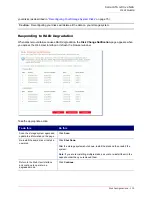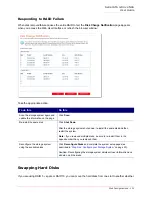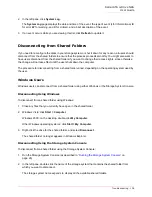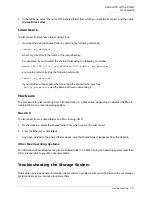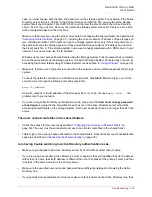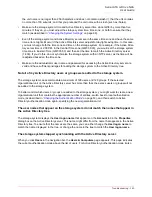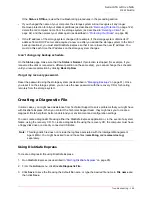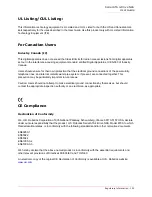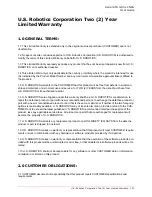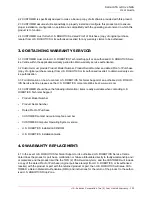
Serial ATA 4-Drive NAS
User Guide
Troubleshooting - 144
If the
Status
is
Offline
, review the troubleshooting procedures in the preceding section.
•
If you changed the name of your computer, the storage system will not recognize it any longer.
Remove protection for all your disks or partitions (as described in
“Removing Protection”
on page 122),
delete the old computer name from the storage system (as described in
“Deleting a Client”
on
page 64), and then protect your disks again (as described in
“Protecting Your Disks”
on page 98).
•
If the IP address of the storage system changed (for example, if the storage system obtains its IP
address from a DHCP server and acquired a new one after you added the storage system to the list of
backup locations), you must start DiskSafe Express so that it can retrieve the new IP address. You
must do this each time the IP address on the storage system changes.
I can’t change my backup schedule.
On the
Status
page, make sure that the
Status
is
Normal
. If protection is stopped (for example, if you
recovered the disk or recovered a different partition on the same disk), you cannot change the schedule
until you resume protection by clicking
Back Up Now
.
I forgot my recovery password.
Reset the password using the storage system (as described in
“Managing Backups”
on page 61). Once
you reset it on the storage system, you can use the new password with the recovery CD or for booting
remotely from the storage system.
Creating a Diagnostic File
In some cases, you might need assistance from Technical Support to solve problems that you might have
with DiskSafe Express. When you contact the Technical Support team, they might ask you to create a
diagnostic file to help them better understand your environment and configuration settings.
You can create a diagnostic file using either the DiskSafe Express application or, in the event of a system
failure, using the recovery CD. To create a diagnostic file using the recovery CD, the computer must have
a floppy disk drive or a directly connected USB disk.
Using DiskSafe Express
To create a diagnostic file using DiskSafe Express:
1. Run DiskSafe Express (as described in
“Starting DiskSafe Express”
on page 95).
2. From the
Action
menu, click
Create Diagnostic File
.
3. Click
Save
to save the file using the default file name, or type the desired file name in
File name
and
then click
Save
.
Note:
This diagnostic file does not include the log files associated with the Intelligent Management
Agent (IMA). You might be asked to send those files (
iscmlib.log
and
iscmservice.log
)
separately.
Содержание USR8700
Страница 1: ...Serial ATA 4 Drive NAS User Guide R46 1702 00 rev 0 8 04 07 ...
Страница 6: ...Serial ATA 4 Drive NAS User Guide vi ...
Страница 8: ...Serial ATA 4 Drive NAS User Guide Safety Instructions 8 ...
Страница 35: ...Serial ATA 4 Drive NAS User Guide Getting Started 33 Windows Mac OS X user CIFS Linux Other Mac user NFS ...
Страница 46: ...Serial ATA 4 Drive NAS User Guide Getting Started 44 ...
Страница 86: ...Serial ATA 4 Drive NAS User Guide Managing Your Storage System 84 ...
Страница 126: ...Serial ATA 4 Drive NAS User Guide Protecting Local Disks 124 ...
Страница 136: ...Serial ATA 4 Drive NAS User Guide Disk Configurations 134 ...

